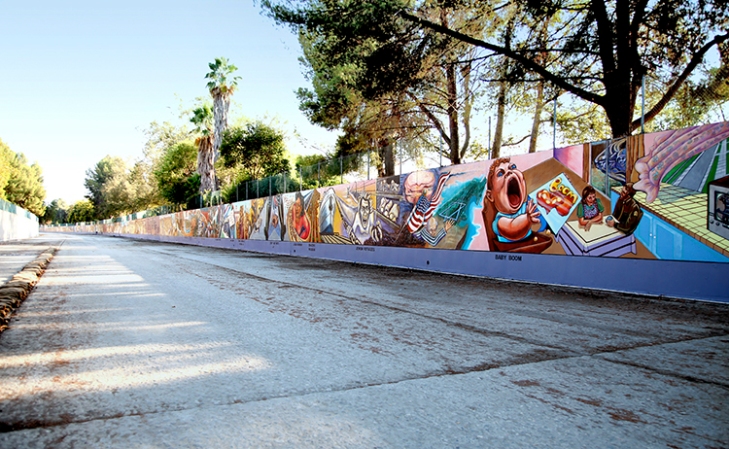ON THE WALL BETWEEN TWO CULTURES, A MURAL
ON THE WALL BETWEEN TWO CULTURES, A MURAL
BY ZACH MORTICE

Judith F. Baca, The Great Wall of Los Angeles, detail with Baby Boom. Image courtesy of SPARC Archive.
In their ability to reappropriate neglected space on a large scale, murals can be defining elements of landscape design. To thousands of landscape architects who will be in Los Angeles this month for the ASLA Annual Meeting and EXPO, Oct. 20-23, this will be good news: The Pacific Standard Time: LA/LA—Latin American and Latino Art in LA festival of thematically linked art exhibits will feature six installations that show how murals reshape our environment and tell hidden stories of marginalized cultures.
This year’s Pacific Standard Time: LA/LA, led by The Getty, focuses on the intersection of Latin American and Latino American art and culture in Los Angeles.

Judith F. Baca, photograph of The Great Wall of Los Angeles. A view of Judy Baca and mural makers meeting at the 1940s section titled David Gonzalez in progress. Photograph courtesy of SPARC Archive.

Judy Baca with The Great Wall of Los Angeles, detail with The Birth of Rock and Roll, summer 1983. Image courtesy of SPARC Archive.
When the mural began, Ontiveros says, there was little gallery and museum support for Chicana artists. Largely excluded from mainstream exhibition venues, Baca received a disused concrete flood channel from a local public art nonprofit (the Social and Public Art Resource Center) as her canvas. And while painting the Tujunga Wash drainage canal (a tributary of the Los Angeles River) in the San Fernando Valley, she and her team had to build sandbag barricades to keep flowing water away.

Mural makers crew, The Great Wall of Los Angeles, detail with Japanese Internment, summer 1981. Image courtesy of SPARC Archive.
“The idea of the environment has been central to her work for over 50 years,” he says.

Judith F. Baca, The Great Wall of Los Angeles, detail with Charles Chaplin and Thomas Alva Edison, 1978. Image courtesy of SPARC Archive.
The five other Pacific Standard Time mural exhibits are:

Ken Gonzales-Day, Danny, mural by Levi Ponce, Van Nuys Blvd., Pacoima, 2016. © 2016 Ken Gonzales-Day.

Emigdio Vasquez, El Proletariado de Aztlán (Detail), 1979. Acrylic on plaster. 8′ x 40′. Chapman University Art Collections. © Emigdio Vasquez Art. Photo: Jessica Bocinski.
California Mexicana: Missions to Murals, 1820–1930 at the Laguna Art Museum, looks at the role the visual arts played in transitioning California’s national identity from Mexico to the U.S. with paintings, posters, prints, and film.
Prometheus 2017: Four Artists from Mexico Revisit Orozco, at the Pomona College Museum of Art, asks four contemporary artists to reinterpret José Clemente Orozco’s 1930 Prometheus fresco at Pomona College.
¡Murales Rebeldes! L.A. Chicana/o Murals Under Siege, at LA Plaza de Cultura y Artes, tells the story of eight murals in Los Angeles that have been threatened, censored, and demolished.
Several more exhibits find ways to look at Latino culture through a landscape design lens beyond murals:
Lineage Through Landscape: Tracing Egun in Brazil by Fran Siegel, at UCLA’s Fowler Museum, traces the plantcentric liturgy and ritual of West African-derived religions, transplanted into South America by the slave trade. Porcelain flowers and textured fabric weavings compile layers of cultural memory.
Jose Dávila: Sense of Place (at West Hollywood Park, 647 N. San Vicente Blvd., West Hollywood, California), hosted by LAND, is a large-scale modular public sculpture that will be disassembled and reconfigured in several Los Angeles landmarks, architectural sites, parks, and open spaces over the course of nine months, before being reassembled.
The U.S.–Mexico Border: Place, Imagination, and Possibility, at the Craft & Folk Art Museum, asks a multidisciplinary group of artists and designers to consider the border as physical infrastructure, the subject of imagination, and as a site of cultural production.
Zach Mortice is a Chicago-based design journalist who focuses on landscape architecture and architecture. You can follow him on Twitter and Instagram.
Comments
Post a Comment